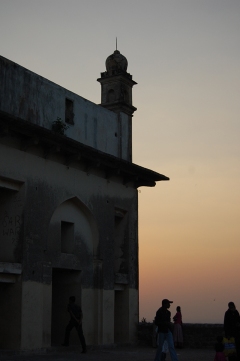BlogCatalog
•October 30, 2009 • Leave a CommentRain Rain Come Again, Little Johny Wants to Shoot
•January 31, 2009 • Leave a CommentRain—a word that reminds all photographers about dehumidifier chambers, dessiccants and that familiar creepy mark on their lenses. But for many Mumbai photographers like me, it is very refreshing thinking about the monsoons, notwithstanding the memories of that terrible flood in 2005. For most of them, it’s a long wait for his dear images.

The long wait for some clouds

I wish there were some clouds on the glass
Wish we had something like a ‘dust filter’ that could be screwed onto the lens like an UV filter.
Canon EOS 5D Mark II and Pentax K-m Reviewed
•January 29, 2009 • Leave a CommentLast month I got the chance to review the 10-megapixel Pentax K-m (K 2000) DSLR and the 10-megapixel Ricoh R10 compact.
The two-lens kit of the Pentax K-m contained the standard DA L 18-55mm f/3.5-5.6 AL and the DA L 50-200mm f/4-5.6 ED lenses. The camera features a built-in CCD-shift Shake Reduction feature, allowing backward compatibility with your old K-mount lenses, making them work like true VR lenses. It uses four AA-type batteries for power and an SD card for storage. The camera gives you the option of saving the RAW images as PEF as well as DNG, allowing compatibility across different platforms.
The Ricoh R10 features a 28-200mm f/3.3-5.2 lens (35mm equivalent) and has an impressive macro mode. It also has a level indicator that warns you when the camera is not level with the ground.
Read the complete review in the February 2009 issue of Smart Photography (now on stands).
Other reviews in the issue: Canon EOS 5D Mark II, Panasonic Lumix LX-3, Canon PowerShot A590 IS.
Also in the issue: Smart Photography Awards 2009, PhotoFair 2009, Learnings—Focus Stacking, Perspective Control, Smart Sharpening, Professional Photo Retouching in Photoshop, Interview with Tarun Khiwal
f-numbers and Their Significance
•January 28, 2008 • 3 CommentsAll of us who are into advanced photography, would be familiar with the numbers associated with aperture of the lenses. These numbers, known as f-numbers, go on as: 1.4, 2, 2.8, 4, 5.6, 8, 11, 16, 22, 32 and so on. But ever wondered why these should be in the form of complicated fractions and not whole numbers? After all, the only significance we find in these numbers is the fact that the light becomes double when we decrease the f-number by two. So life would have been much simpler without all these fractions…right? But what is the significance of these fractions?
f-number is a measure of the ‘relative aperture’ of a lens. This is the ratio of the focal length of the lens to the diameter of lens opening (aperture).
i.e.,
f-number = focal length/iris diameter
In other words, it is the number of diameters of the lens opening present in the given focal length. Hence when the f-number is 2.8, the focal length of the lens is 2.8 times the diameter of the iris opening. This is why the number becomes smaller as the aperture grows larger. When we change the f-number to the one near it, we say that the light changes by an f-stop. The f-stops have been selected such that when we increase the aperture by one f-stop (or decrease the f-number by one unit), light intensity doubles. And since intensity of light is proportional to the square root of distance, each f-number is √2 times the one preceding it. So the numbers double for every two stops.
Hence, the f-numbers can be written as:
1, 1 x √2, 1 x √2 x √2, 1 x √2 x √2 x √2, 1 x √2 x √2 x √2 x √2, 1 x √2 x √2 x √2 x √2 x √2,…
i.e., 1, 1.4, 1.979, 2.8, 3.959, 5.6, 7.919,11.2,…
After correction to the nearest decimal point, this series becomes:
1, 1.4, 2, 2.8, 4, 5.6, 8, 11,…
Exposure
•January 25, 2008 • 3 CommentsA camera is nothing but a light tight box with a medium to record images, and some mechanism to control the amount of light falling on the recording medium. The amount of light striking a particular point can be controlled by either limiting the size of the opening, or by limiting the time for which light is allowed to pass. The mechanism to reduce the opening is known as Aperture, while the one to limit the time for which the light is passed is known as shutter, which controls the Shutter Speed. Thus, the two parameters—aperture and shutter speed—control the exposure taking place on the light-sensitive medium
So for the exposure to be correct, the combination of aperture and shutter speed should be correct. If the image appears darker than the scene (i.e. the light striking the medium is less than optimal), the image is said to be under exposed. On the contrary, if the image is lighter (i.e. the light striking the medium is more) than than required, the image is said to be over exposed.




Recent Comments